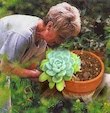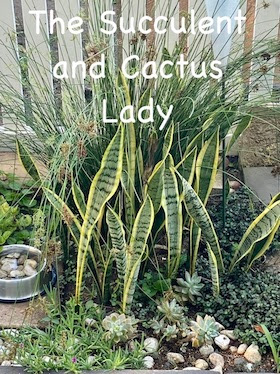I never thought I’d be saying, ‘waiting for the rain’ so soon after the massive floods we had here on the Dolphin Coast a mere three or four weeks ago (we had 244mm in less than 23 hours), but if I don’t bring out the hosepipe soon, I’m going to have a very grumpy succulent garden on my hands. Under the Tradescantia (above), the Callisia repens is dry and brittle and I have actually removed huge patches of it (they spread like a wild-fire anyway) to make way for new growth. Provided I water it. All the plants here at the coast are used to regular rain, at least twice a week, so no rain for the past month is not good.
About me

🌿 I've been gardening ever since a child, when I spent time with my father in his vegetable garden. But my fascination with Echeverias started in the 1980's, when my father gave me a pot with five Echeverias, which turned out to be E. imbricata. At first I wasn't much interested in them and planted them in some obscure corner of the garden and completely forgot about them. How great was my surprise when, a couple of months later, I noticed that they had spread and made a beautiful display - I was hooked!
Pages
Sunday 8 May 2022
Waiting for the rain
Monday 2 May 2022
Spekboom, loved by elephants and butterflies alike
Spekboom also make great container plants and already the birds enjoy roosting in the one above as it is near their favourite bathing place. Spekboom is totally edible and widely used in salads. I've often seen the birds taking bits of the leaves. The taste of spekboom leaves are pleasant but changes throughout as the sun rises and sets. During the day leaves have an acid flavour and they become less acidic towards the evening. The delicious greenery is heavily browsed by game and firm favourite of several wild animals, especially elephants! There the English name of Elephant Bush.
The leaves are used medicinally and in traditional home construction. Here are the most popular traditional and contemporary uses of spekboom leaves:
- - Sucking a leaf to quench thirst, treat exhaustion, dehydration and heatstroke.
- - Using crushed leaves to provide relief for blisters.
- - Chewing leaves can treat a sore throat and mouth infections.
- - Juiced leaves are used as an antiseptic and to soothe skin ailments such as pimples, rashes, - insect stings and sunburn.
- - In certain areas, the stems are used to help build huts/homes. The stems are dried and used as thatch for rooves of the huts/homes.
- - In Mozambique, breastfeeding mothers eat spekboom leaves to increase their milk supply.
- - During famine, the Zulus eat the leaves raw.
- (This information from Shamwari Game Reserve)
The spekboom flowers are nectar-rich and provide food for many insects – endangered bees love them! This, in turn, attract insectivorous birds.












